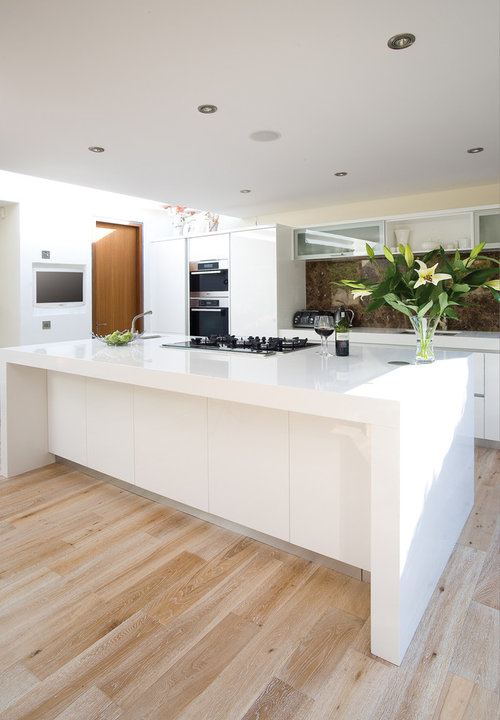Imagine walking into your kitchen, the morning sun streaming through the window, reflecting off the warm glow of your hardwood floors. It’s a picture of beauty and elegance, but is it practical? Can hardwood floors, traditionally associated with living rooms and bedrooms, truly withstand the demands of a kitchen?

Image: mromavolley.com
The answer: It’s more complicated than a simple yes or no. While hardwood floors can absolutely thrive in a kitchen, it requires careful consideration and perhaps some adjustments to your daily routine. This article will navigate the pros and cons, exploring why some kitchens are a perfect match for hardwood flooring and help you determine if it’s the right choice for your space.
Why Hardwood Floors Are a Popular Choice For Kitchens
The appeal of hardwood floors in kitchens extends beyond their aesthetic allure. They offer several advantages, making them a top contender for many homeowners:
- Durability: Hardwood floors are known for their longevity. With proper care, they can endure years of traffic, spills, and even the occasional dropped knife without showing significant damage.
- Easy Cleaning: Sweeping, mopping, and even washing your hardwood floors is a breeze compared to other materials like carpets. This makes maintaining a clean and hygienic kitchen simple.
- Style and Versatility: Hardwood floors come in a myriad of species, colors, and finishes, allowing you to create a unique aesthetic that complements your kitchen’s style, whether it’s rustic, modern, or traditional.
- Increased Home Value: Hardwood floors are a coveted feature that can enhance your home’s value. When done right, they add a touch of sophistication and luxury that potential buyers appreciate.
The Challenges of Hardwood Floors in Kitchens
While hardwood floors offer significant benefits, it’s essential to acknowledge the challenges they present in a kitchen environment:
- Water Damage: Water is the biggest enemy of hardwood floors. Spills, steam from cooking, and even humidity can cause warping, buckling, and even rotting if not addressed promptly.
- Scratches and Dents: Heavy pots, sharp knives, and even high-heeled shoes can leave their mark on hardwood floors. The susceptibility to scratches and dents can be a concern depending on the type of wood and finish chosen.
- Maintenance: Maintaining the shine and integrity of hardwood floors requires regular cleaning, periodic refinishing, and the occasional touch-up of scratches or dents.
Making Hardwood Floors Work in Your Kitchen
Despite the challenges, hardwood floors can be a beautiful and practical choice for your kitchen with some strategic planning and careful consideration. Here’s a breakdown of crucial aspects to consider:

Image: bestchoicemakers.com
1. Choose the Right Wood
Not all wood species are created equal. Some are naturally harder and more resistant to scratches and dents, making them better suited for high-traffic areas like kitchens:
- Hardwoods: Oak, maple, cherry, and hickory are known for their durability and resistance to wear and tear.
- Engineered Hardwood: This option combines a top layer of real hardwood with plywood, offering increased stability and moisture resistance.
2. Select a Suitable Finish
The finish applied to your hardwood floors plays a significant role in their durability and resistance to water damage. Options include:
- Polyurethane: This durable finish provides a protective barrier against scratches, spills, and wear and tear.
- Oil-Based Polyurethane: Known for its high gloss and water resistance, it requires more drying time but offers excellent protection.
- Water-Based Polyurethane: Offers a faster drying time, lower VOC emissions, and comes in various sheen levels.
3. Consider a Protective Layer
Adding an extra layer of protection can offer peace of mind and mitigate the risk of water damage. Options include:
- Area Rugs: Place strategically placed rugs in high-traffic areas and near sinks to absorb spills and create a soft landing for dropped items.
- Sealant: Applying a sealant to your hardwood floors can enhance their water resistance and make them easier to clean.
4. Mind Your Routine
Even with the best hardwood floors and protective measures, kitchen activities contribute to wear and tear. To minimize damage and maintain the beauty of your floors, consider these practices:
- Clean Spills Immediately: Act fast to prevent staining or warping. Mop up spills before they have a chance to soak into the wood.
- Use Mats: Place mats in front of sinks, stoves, and the refrigerator to protect floors from water splashes and food particles.
- Invest in Floor Protectors: Consider using felt pads under furniture legs, coasters under glasses and mugs, and kitchen mats to minimize scratches and dents.
Hardwood Alternatives for Kitchens
For those who remain hesitant about hardwood floors in kitchens, several alternatives offer similar beauty and durability with greater water resistance:
- Luxury Vinyl Plank (LVP): A popular choice due to its affordability, durability, and wide range of styles mimicking real hardwood.
- Ceramic or Porcelain Tiles: Offers superior water resistance and durability, but can feel cold underfoot.
- Laminate Flooring: Cost-effective and durable, but may not offer the same natural appeal as hardwood.
Can You Put Hardwood Floors In A Kitchen
Making the Decision
Choosing the right flooring for your kitchen depends on your lifestyle, budget, and aesthetic preferences. If you appreciate the timeless elegance and durability of hardwood floors, but are concerned about water damage and maintenance, careful planning and investment in appropriate finishes and protective measures can make it a viable and beautiful solution. However, if you prioritize water resistance and low maintenance, explore the alternatives mentioned, weighing their pros and cons to find the perfect fit for your kitchen.





